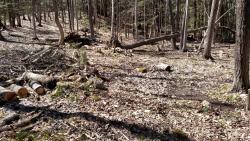This is a picture of the back of my property. This area that is part of my lot, that I'm thinking of slowly turning into a food forest is a North facing slope with 5-10 percent slope. So, a little rise/slope but not too bad. To the right of the trees with the orange marker tape is my area, this is looking south. The lot is many hundred feet north to south, but only about 175 feet east to west.
It is also very rocky, but the soil that is there seems rich.
There is no opening in the canopy really, just dappled sunlight through the area.
There is some water that runs through this area and I can control some of that runoff if I want to for water, but currently this area is quite wet and bordering a little swampy/mucky. There are a lot of little humps/swells in the earth that are much dryer as well on the other side of the lot. Mixed forest and ferns dominate the landscape currently.
I have in mind to thin some of the trees and start at what would be the center area of a garden or food forest and then start working outward from that center spot. I've been here about 5 years and have been thinking of this project on and off, but not really sure where how to start - sunlight seems like the biggest issue; just too many trees.
This is a project for fun, but also - the idea is to serve as an emergency preparedness area in case of some catastrophic emergency for food, and also I figure someday, someone, me and my family or people to come later will benefit from something like this down the road, well - if I can make something of it.
Any words of wisdom from experience?
the second picture is the center of the area I'm thinking of converting and is about about 75 feet west of the first picture. this area I can get a garden tractor too. I really don't feel like I've done much, but just getting the area accessible has been quite an effort popping rocks out of the earth to make trails. This is about 4 or 500 feet up in the woods from the main house lot.




